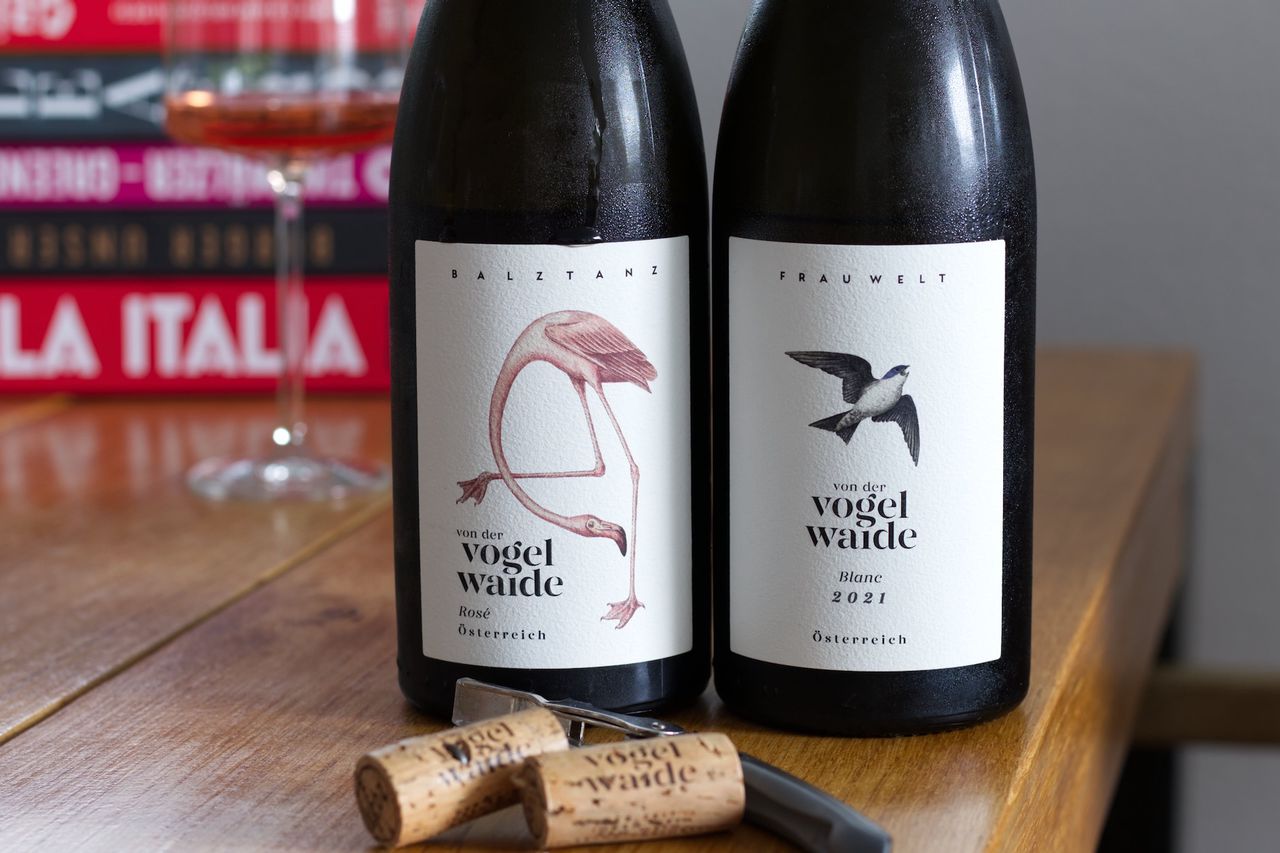Two Bottles Von Der Vogelwaide
We are drinking two bottles from Von der Vogelwaide in the Wachau region of Austria: a 2021 Balztanz Rosé and a 2021 Frau Welt Blanc.

Less than two weeks ago, in the conclusion of our trip to the Rhine front in Rheinhessen, we talked about how many glasses were actually raised not because of the wine, but because of the label. I have no doubt that the same would have happened with these two bottles. This behaviour directly translates to online shopping, which is why these bottles are here. The Wachau region, although I liked the bottle from Nikolaihof very much, doesn’t typically fall within my target range. I can’t quite say why, because aside from these now three bottles, I’ve had very little wine from Wachau. It’s probably an unconscious reputation thing, a bit like with grape varieties. I associate Wachau with (perhaps too) much wine in the glass, some might say overly rich, a bit dusty, old-fashioned, and somehow demanding. Regardless of whether this image is accurate or not, Daniel Vogelwaid and Michael Donabaum had nothing to do with it. They founded Von der Vogelwaide together in 2019, deliberately not wanting to call it a winery, château, or domain. Daniel originally comes from Württemberg and, after an apprenticeship at Wöhrwag and studying in Geisenheim, amassed an impressive list of workplaces: Domaine de l’Horizon in southern France, Jean Louis Chave in the Rhône, Comtes Lafon in Burgundy, Château Palmer in Bordeaux, and Helmut Dolde in beautiful Linsenhofen not far from here. He is particularly taken with the Rhône, so there will also be his own Syrah in the coming years. Michael is rooted in the Wachau and grew up on his parents’ winery, studied viticulture in Krems, and worked with Franz Hirtzberger, Von Winning, Peter Skoff, and Tokara in South Africa. He didn’t have his own vineyards available but had contacts. And what do you do when you’re starting out but have no vineyards? Right: plaster the area with posters saying “Looking for vineyards, including hard-to-reach plots and fallow land” and dig the vineyards, sorry, gardens as they are called in Austria, out from under thorns and brush, and replant some. By now, they have about three hectares of land managed biodynamically. The rosé with the pelican on the bottle, Balztanz, is a 2021 blend of Zweigelt and Merlot. The white wine with the swallow on the bottle, Frau Welt, is a 2021 blend of Neuburger, Riesling, and Grüner Veltliner. All vineyards are worked by hand, the grapes are spontaneously fermented, and partially aged in small oak barrels. Unusual for the Wachau, and not allowed if you want to write a classification on the bottle. But we’re familiar with winemakers who can write very little on their bottles here.
Frau Welt starts nutty, with a bit of puffed grain and very restrained fruit. Perhaps some apples, mealy, more yellow than green. This is clearly a structured wine, living more on how it feels when you smell it, how it tickles associations deep in the subconscious, rather than making you want to shout cherry. And it tastes that way too. Mineral, salty, and cool. Super clean, straightforward, and with a lot of drive. It pulls the cheeks together, the tongue (if it can) rolls, and you immediately want another sip. You don’t necessarily need another sip though because what happens on the tongue lingers for a long time. I really like that, and it’s pretty much the opposite of any prejudice I might have had about the Wachau.
The nutty, puffed grain steps back after a night in the fridge. The wine becomes more herbal, spicier, and also more citrusy. The structure while drinking remains brilliant. There’s so much grip in the wine, so much pull, and the citrus note reappears. Like lemon juice, where you pressed too hard and got more white pith than you wanted. That’s also the moment at which I type Neuburger into a search engine, because I’ve never heard of it before. The first hit is Leberkäse. I’d like some of that, but it’s not in the wine. The next hit mentions nutty aroma and indigenous variety of the Wachau. That must be it, and the wine is indeed still nutty. Although Veltliner and Riesling also play a significant role. A great wine.
The order of tasting wasn’t well thought out. The Balztanz struggles after Frau Welt. Very restrained, quiet, with very fine berry fruit and also some apples, you have to enthusiastically stick your nose in the glass. And it doesn’t really let itself be grasped. Each swirl changes the smell, never allowing you to pin it down. It tastes a bit of orange and grapefruit, with a lot of freshness, and here too, there’s structure in the wine. And what started very quietly becomes more intense with air and builds layer upon layer on the tongue.
Oxygen has as much influence as temperature. This is particularly noticeable straight from the fridge on the second evening. You have to stick your nose deep into the glass again. A few degrees more and there’s more to smell. There are fruit gum raspberries with a white substance in the core. I think they exist, my better half isn’t so sure. Somehow, the wine reminds me of that. At least in its fruit. Then come herbs and again the grapefruit. The acidity has a lot of drive and sets the pace. This is one of those wines where I wonder why I don’t drink rosé more often. Until I remember how most rosé tastes. Maybe that’s not so bad in the end because such a bottle shines even brighter.